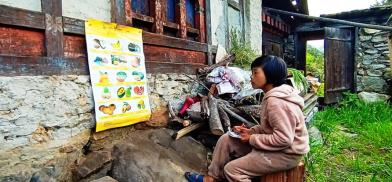Teachers cannot reach students in the highlands
While some parents are concerned about students not getting the best of online education, teachers in the Bhutanese highlands are waiting for students to return from cordyceps collections to continue online education

While some parents are concerned about students not getting the best of online education, teachers in the Bhutanese highlands are waiting for students to return from cordyceps collections to continue online education.
Many students away with their parents for cordyceps collections, especially in Lunana and Laya, teachers have not been able to implement the adapted curriculum fully.
Of the 40 students in Lunana Primary School (PS), only seven are at home.
The students went with parents because of the school closure owing to Covid-19 where boarding facility was closed too.
Lunana PS has five teachers.
Officiating principal of Lunana PS, Phub Gyeltshen, said that usually when the parents leave for cordyceps collections, the students stay back to continue the education.
“However, this time, since there was no option for parents to keep their children without a guardian at home, they took their children with them,” he said. “The reason for having boarding facilities in the first place was to help students not get disturbed during cordyceps collections apart from being located far away from school.”
Lunana gewog issued the permits to around 150 collectors on May 25. The collectors left for the fungus collection on June 1. Cordyceps is the main source of income for the people of Lunana.
Phub Gyeltshen said that because it was difficult to reach out to children due to scattered villages, students leaving with parents added to the challenges in implementing the adapted curriculum to keep the students engaged.
Teachers had been going door-to-door with Self Instructional Materials (SIM). Most villages in Lunana are more than 30 minutes to a day’s walk from the school.
A few villages are more than three days’ walk away from school and entirely cut off from television or internet connectivity.
“We’ve managed to drop SIM to the students. But this time, there are no students, and it wouldn’t be easy for us to go to cordyceps collection locations,” Phub Gyeltshen said.
The schools are also waiting for materials like curriculum guides, teaching materials, learning materials that couldn’t be delivered due to bad weather and road conditions.
However, teachers are managing with the soft copies they have received.
Phub Gyeltshen said that in Wachay, a day walk from Lunana, only eight students are studying in the third standard. The school has nominated a villager to teach the students using the SIM.
“He is a farmer who is a literate and has volunteered to teach every day,” he said, adding they had to come up with this idea, as it was not possible to walk to the village every day.
From Threlga, which is about three hours’ walk from Lunana PS, a total of nine children had joined the school this year and was supposed to learn from SIM. But they have also left with the parents.
The extended classroom (ECR) at Thanza has 31 students and the one in Mendrelthang has 13. Students are still in village and the teachers have been teaching the students.
Cordyceps collection will end on July 15.
Phub Gyeltshen said that once the students are back, teachers would take turns to teach the student and divide students into small groups. “We must do this given a poor network and internet service. We’re worried since we need to assess them for promotion too.”
Only 30 percent of the students in Laya Central School is in the village according, to the school administration. The school with boarding facility has 179 students from PP-IX.
“Since most of the villages are only about 30 minutes’ walk from the school, we wanted to drop the learning materials and follow up, but students were not available,” a teacher said. “Earlier, we’ve been teaching through WeChat and assigning activities but is difficult with a poor network.”
Once the students are back, teachers would continue to assign activities through WeChat or Google classroom and implement an adapted curriculum. However, the class for grade X has resumed as directed.
Meanwhile, although it was the same case in Lingzhi PS in Thimphu that has Classes PP-VI with 52 students, the teachers have managed to visit the students at the cordyceps collection sites.
Principal Dawa Tshering said that almost 80 percent of the students had left with parents.
“Students go to a place where there is a mobile network and call teachers to clear their doubts,” he said. “The teachers have already travelled thrice to drop the SIM to engage students and also to monitor them.”
https://kuenselonline.com/teachers-cannot-reach-students-in-the-highlands/








Post a Comment